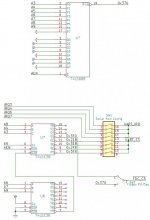nztdm
Experienced Member
Hello
I have built many floppy+serial+bootROM boards based on Sergey's schematic: http://www.malinov.com/Home/sergeys-projects/isa-fdc-and-uart
This schematic has the FDC hard wired as primary.
My goal is to modify the schematic to be able to switch to secondary.
Sergey's Multi-floppy BIOS 2.2 supports a secondary controller.
I believe this only requires changing the chip-select circuit to activate the floppy controller IC's chip-select at port 370h, instead of 3F0h.
Should be able to keep the same IRQ6 and DMA2?
Floppy controller used is PC8477BV-1
I can't figure out the puzzle of using the existing two 74LS138 ICs, if it's possible at all.
I think I may have figured it out by adding an identity comparator 74HCT688.

I wired this up, and it seems to work somewhat, but has issues, so there is probably a conflict occurring due to something I missed.
It will work for a few accesses (such as booting from a DOS floppy, or booting from HDD then running some CheckIt floppy read tests), and then both primary and secondary controllers no longer work until a power cycle (reset isn't enough).
Once the failure has occurred:
I have tried with IRQ 5 instead of 6 for the secondary FDC, with no change.
The 74HCT688 has a 100nF capacitor.
Any ideas? I must be missing something with the identity comparator circuit.
I have built many floppy+serial+bootROM boards based on Sergey's schematic: http://www.malinov.com/Home/sergeys-projects/isa-fdc-and-uart
This schematic has the FDC hard wired as primary.
My goal is to modify the schematic to be able to switch to secondary.
Sergey's Multi-floppy BIOS 2.2 supports a secondary controller.
I believe this only requires changing the chip-select circuit to activate the floppy controller IC's chip-select at port 370h, instead of 3F0h.
Should be able to keep the same IRQ6 and DMA2?
Floppy controller used is PC8477BV-1
I can't figure out the puzzle of using the existing two 74LS138 ICs, if it's possible at all.
I think I may have figured it out by adding an identity comparator 74HCT688.

I wired this up, and it seems to work somewhat, but has issues, so there is probably a conflict occurring due to something I missed.
It will work for a few accesses (such as booting from a DOS floppy, or booting from HDD then running some CheckIt floppy read tests), and then both primary and secondary controllers no longer work until a power cycle (reset isn't enough).
Once the failure has occurred:
- CheckIt can't read the disk.
- DOS gives "Data error reading drive A"
- MultiFloppy BIOS gives Error 08 when trying to boot.
- XT-IDE BIOS (after MultiFloppy BIOS) gives Error 8h when trying to boot from floppy.
I have tried with IRQ 5 instead of 6 for the secondary FDC, with no change.
The 74HCT688 has a 100nF capacitor.
Any ideas? I must be missing something with the identity comparator circuit.
Attachments
Last edited:


